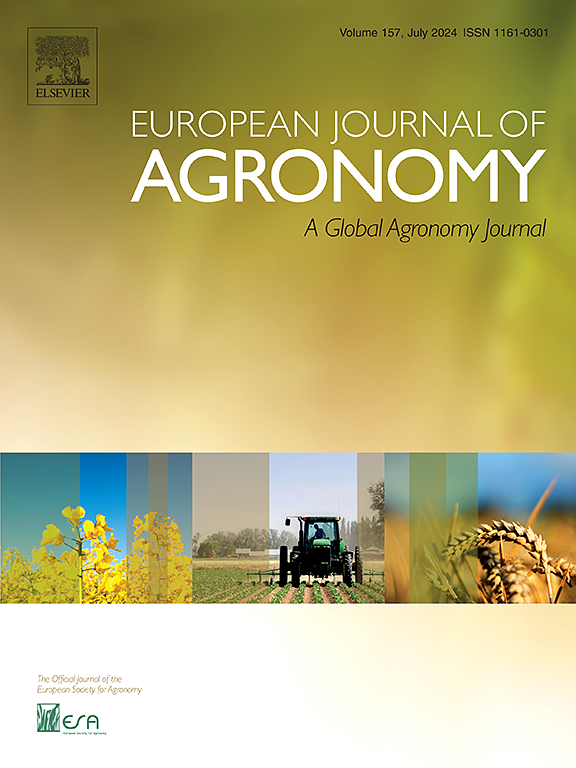Grazing and precipitation addition interactions alleviate dominant species overgrowth and promote community productivity and biodiversity in a typical steppe
IF 4.5
1区 农林科学
Q1 AGRONOMY
引用次数: 0
Abstract
Grazing and precipitation are pivotal factors influencing the productivity and biodiversity of grassland ecosystems, largely through their effects on the growth and reproduction of dominant species. Approximately 50 % of terrestrial ecosystems are concurrently affected by grazing and precipitation addition (PA), yet the interactive effects of these factors remain underexplored. To elucidate the combined impacts of grazing and PA on the growth of dominant species and their influence on community structure and function, we initiated a four-year combined grazing and PA experiment based on a long term of grazing experiment in a typical steppe. The synergistic interaction between PA and grazing enhanced canopy diameter (CD), tiller density (TD), and seedling density (SD) in dominant species, while decreasing reproductive branch density (RB). Conversely, an antagonistic interaction increased plant height (PH) and TD but reduced SD. These responses suggest that dominant species adapt to combined grazing and PA pressures by shifting growth strategies towards lateral growth and asexual reproduction. The growth characteristics of dominant species exhibited four response patterns to grazing and PA interactions: full saturation, sufficient saturation, equal saturation, and deficit saturation, each with three corresponding thresholds: adaptation, optimum, and saturation points. Grazing decreased the precipitation response thresholds for PH, CD, RB, and population density, while increasing the optimal points for TD and SD. These changes in the growth of the dominant species resulted in a 33 % reduction in the aboveground biomass (AGB) of the community and triggered a 18 % increase in the coupling index between AGB and species richness within the community. Our findings highlight the role of dominant species in facilitating community adaptation to increased precipitation and rotational grazing, offering critical insights for developing sustainable grazing strategies under climate change.
放牧和降水的相互作用缓解了典型草原上优势物种的过度生长,提高了群落生产力和生物多样性
放牧和降水是影响草原生态系统生产力和生物多样性的关键因素,这主要是通过它们对优势物种的生长和繁殖的影响来实现的。约有 50% 的陆地生态系统同时受到放牧和降水增加(PA)的影响,但这些因素的交互作用仍未得到充分探索。为了阐明放牧和 PA 对优势物种生长的综合影响及其对群落结构和功能的影响,我们在典型草原长期放牧实验的基础上,启动了一项为期四年的放牧和 PA 综合实验。PA和放牧之间的协同作用增强了优势物种的冠层直径(CD)、分蘖密度(TD)和幼苗密度(SD),同时降低了生殖枝密度(RB)。相反,拮抗作用增加了植株高度(PH)和分蘖密度(TD),但降低了分蘖密度(SD)。这些反应表明,优势物种通过将生长策略转向侧向生长和无性繁殖来适应放牧和PA的双重压力。优势物种的生长特征表现出四种对放牧和PA相互作用的响应模式:完全饱和、充分饱和、同等饱和和不足饱和,每种模式都有三个相应的阈值:适应点、最佳点和饱和点。放牧降低了 PH、CD、RB 和种群密度的降水响应阈值,同时提高了 TD 和 SD 的最佳点。优势物种生长的这些变化导致群落的地上生物量(AGB)减少了33%,并使群落内AGB与物种丰富度之间的耦合指数增加了18%。我们的研究结果突显了优势物种在促进群落适应降水增加和轮牧方面的作用,为在气候变化下制定可持续的放牧策略提供了重要的启示。
本文章由计算机程序翻译,如有差异,请以英文原文为准。
求助全文
约1分钟内获得全文
求助全文
来源期刊

European Journal of Agronomy
农林科学-农艺学
CiteScore
8.30
自引率
7.70%
发文量
187
审稿时长
4.5 months
期刊介绍:
The European Journal of Agronomy, the official journal of the European Society for Agronomy, publishes original research papers reporting experimental and theoretical contributions to field-based agronomy and crop science. The journal will consider research at the field level for agricultural, horticultural and tree crops, that uses comprehensive and explanatory approaches. The EJA covers the following topics:
crop physiology
crop production and management including irrigation, fertilization and soil management
agroclimatology and modelling
plant-soil relationships
crop quality and post-harvest physiology
farming and cropping systems
agroecosystems and the environment
crop-weed interactions and management
organic farming
horticultural crops
papers from the European Society for Agronomy bi-annual meetings
In determining the suitability of submitted articles for publication, particular scrutiny is placed on the degree of novelty and significance of the research and the extent to which it adds to existing knowledge in agronomy.
 求助内容:
求助内容: 应助结果提醒方式:
应助结果提醒方式:


